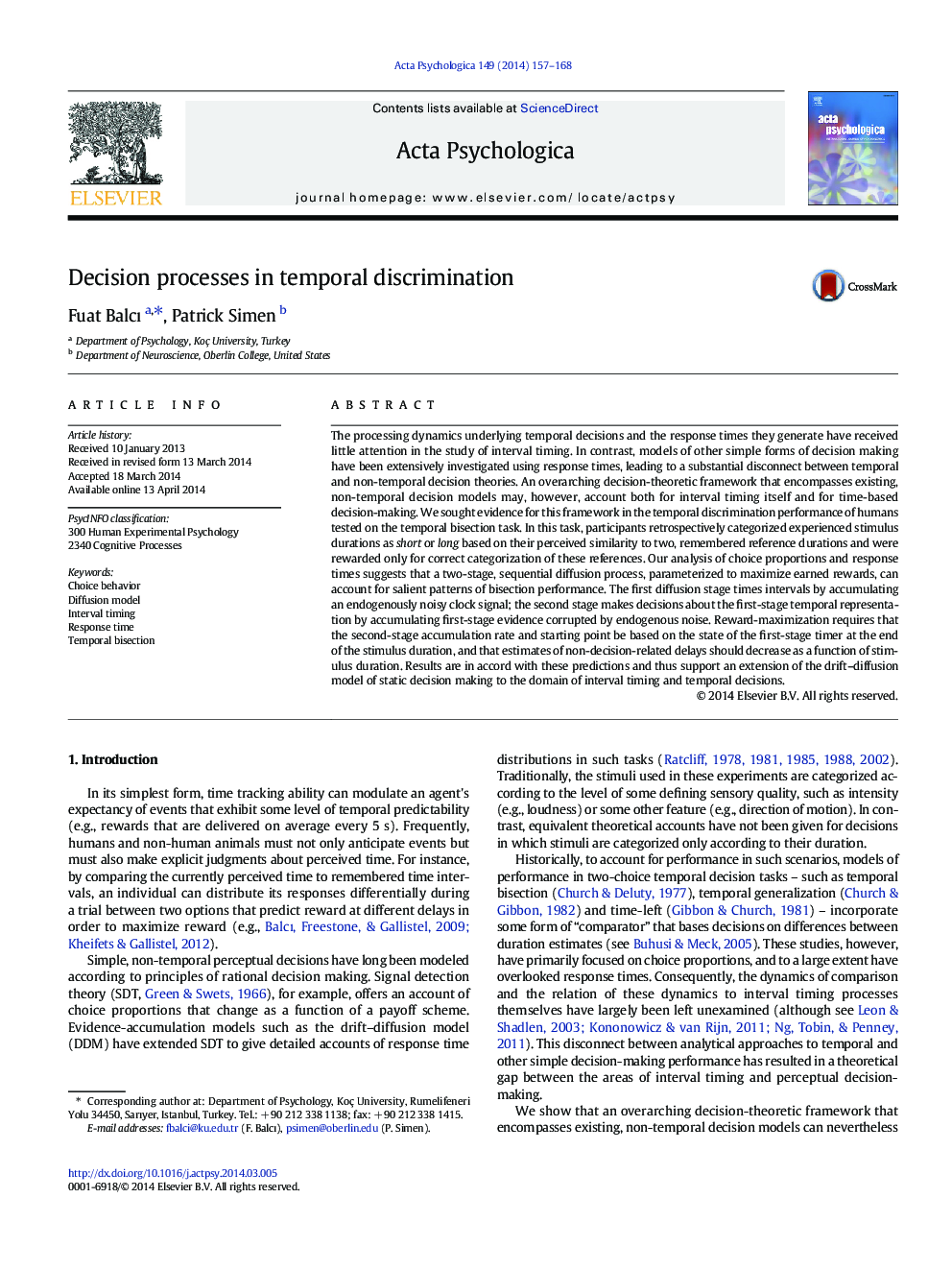| کد مقاله | کد نشریه | سال انتشار | مقاله انگلیسی | نسخه تمام متن |
|---|---|---|---|---|
| 7277718 | 1473609 | 2014 | 12 صفحه PDF | دانلود رایگان |
عنوان انگلیسی مقاله ISI
Decision processes in temporal discrimination
ترجمه فارسی عنوان
روند تصمیم گیری در تبعیض زمانی
دانلود مقاله + سفارش ترجمه
دانلود مقاله ISI انگلیسی
رایگان برای ایرانیان
کلمات کلیدی
300 روانشناسی تجربی انسانی، 2340 فرآیندهای شناختی، رفتار انتخابی، مدل توزیع، زمان بندی فاصله، زمان پاسخ، بیوسیک زمانی،
ترجمه چکیده
دینامیک پردازش مبتنی بر تصمیمات زمانی و زمان پاسخ آنها، توجه کمی را در مطالعه زمانبندی فاصله انجام داده است. در مقابل، مدل های دیگر فرم های ساده تصمیم گیری، با استفاده از زمان پاسخ، به طور گسترده مورد بررسی قرار گرفته اند، و منجر به اختلاف قابل توجهی بین نظریه های تصمیم گیری زمانی و غیر زمانی می شود. با این وجود چارچوب نظری تصمیم گیری جامع که شامل مدل های تصمیم گیری غیرموجب در حال حاضر می باشد، می تواند برای خود زمانبندی زمانبندی و تصمیم گیری مبتنی بر زمان حساب کند. ما برای شواهدی از این چارچوب در عمل تبعیض زمانی انسانهایی که بر روی کار برانگیختن زمان مواجه شده اند، تلاش کردیم. در این وظیفه، شرکت کنندگان به طور خلاصه دوره های محرک تجربه شده را به عنوان کوتاه مدت یا طولانی براساس شباهت درک شده خود با دو دوره زمانی مرجع یاد شده طبقه بندی کردند و فقط برای طبقه بندی صحیح این منابع ارایه شدند. تجزیه و تحلیل ما از نسبت های انتخابی و زمان پاسخ نشان می دهد که فرآیند انتشار دو مرحله ای، پارامتریک برای به حداکثر رساندن پاداش های به دست آمده، می تواند برای الگوهای برجسته عملکرد اختلاط حساب شود. اولین مرحله پخش فاز، با جمع آوری یک سیگنال ساعت درونزایانه پر سر و صدا، مرحله دوم، تصمیم گیری دربارۀ بازنمایی زمانبندی مرحله ی اول را با جمع آوری شواهد در مرحله اول که توسط سر و صدایی درون زده خراب شده است، می گیرد. به حداکثر رساندن پاداش لازم است که نرخ انباشت دوم مرحله و نقطه شروع بر اساس وضعیت تایمر مرحله اول در پایان مدت زمان محرک باشد و تخمین ها از تاخیر های غیر تصمیم گیری به عنوان یک عامل از محرک ها مدت زمان. نتایج مطابق با این پیش بینی ها هستند و بنابراین از گسترش مدل رانش-افشای تصمیم گیری های استاتیک به حوزه زمانبندی فاصله و تصمیم گیری های موقتی حمایت می کنند.
موضوعات مرتبط
علوم زیستی و بیوفناوری
علم عصب شناسی
علوم اعصاب شناختی
چکیده انگلیسی
The processing dynamics underlying temporal decisions and the response times they generate have received little attention in the study of interval timing. In contrast, models of other simple forms of decision making have been extensively investigated using response times, leading to a substantial disconnect between temporal and non-temporal decision theories. An overarching decision-theoretic framework that encompasses existing, non-temporal decision models may, however, account both for interval timing itself and for time-based decision-making. We sought evidence for this framework in the temporal discrimination performance of humans tested on the temporal bisection task. In this task, participants retrospectively categorized experienced stimulus durations as short or long based on their perceived similarity to two, remembered reference durations and were rewarded only for correct categorization of these references. Our analysis of choice proportions and response times suggests that a two-stage, sequential diffusion process, parameterized to maximize earned rewards, can account for salient patterns of bisection performance. The first diffusion stage times intervals by accumulating an endogenously noisy clock signal; the second stage makes decisions about the first-stage temporal representation by accumulating first-stage evidence corrupted by endogenous noise. Reward-maximization requires that the second-stage accumulation rate and starting point be based on the state of the first-stage timer at the end of the stimulus duration, and that estimates of non-decision-related delays should decrease as a function of stimulus duration. Results are in accord with these predictions and thus support an extension of the drift-diffusion model of static decision making to the domain of interval timing and temporal decisions.
ناشر
Database: Elsevier - ScienceDirect (ساینس دایرکت)
Journal: Acta Psychologica - Volume 149, June 2014, Pages 157-168
Journal: Acta Psychologica - Volume 149, June 2014, Pages 157-168
نویسندگان
Fuat Balcı, Patrick Simen,
